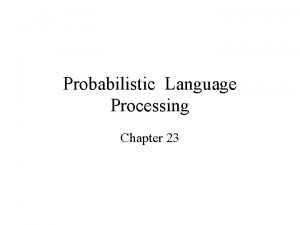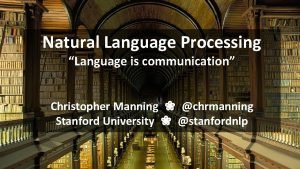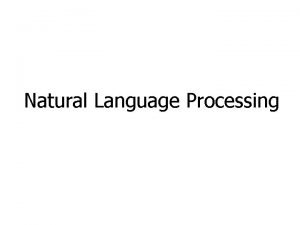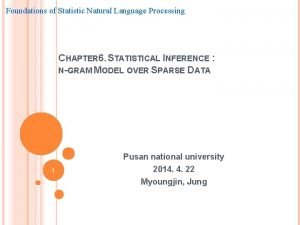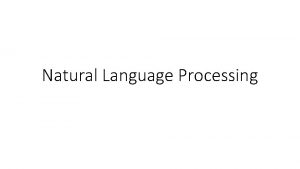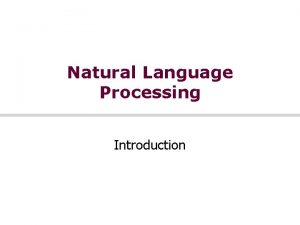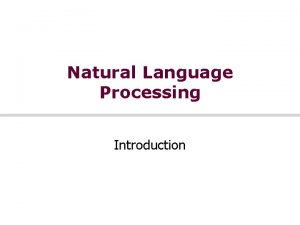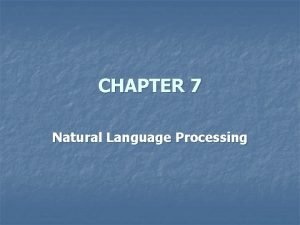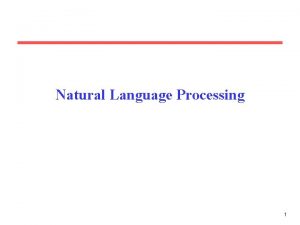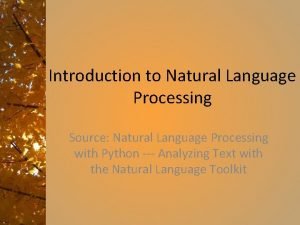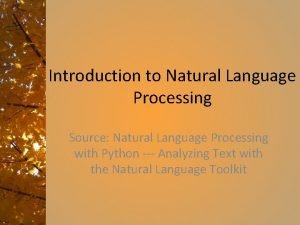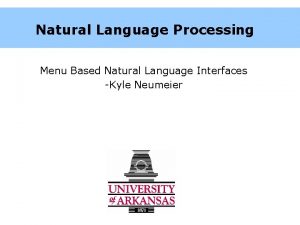Natural Language Processing Introduction to Natural Language Processing










- Slides: 10

Natural Language Processing

Introduction to Natural Language Processing �Language meant for communicating with the world. �Also, By studying language, we can come to understand more about the world. �If we can succeed at building computational mode of language, we will have a powerful tool for communicating with the world. �Also, We look at how we can exploit knowledge about the world, in combination with linguistic facts, to build computational natural language systems.

Natural Language Processing (NLP) problem can divide into two tasks: 1. Processing written text, using lexical, syntactic and semantic knowledge of the language as well as the required real-world information. 2. Processing spoken language, using all the information needed above plus additional knowledge about phonology as well as enough added information to handle the further ambiguities that arise in speech.

Steps in Natural Language Processing Morphological Analysis �Individual words analyzed into their components and non-word tokens such as punctuation separated from the words. Syntactic Analysis �Linear sequences of words transformed into structures that show the words relate to each other. �Moreover, Some word sequences may reject if they violate the language’s rule for how words may combine. Semantic Analysis �The structures created by the syntactic analyzer assigned meanings. �Also, A mapping made between the syntactic structures and objects in the task domain. �Moreover, Structures for which no such mapping possible may reject. Discourse integration �The meaning of an individual sentence may depend on the sentences that precede it. And also, may influence the meanings of the sentences that follow it.

Summary � Results of each of the main processes combine to form a natural language system. � All of the processes are important in a complete natural language understanding system. �Not all programs are written with exactly these components. �Sometimes two or more of them collapsed. � Doing that usually results in a system that is easier to build for restricted subsets of English but one that is harder to extend to wider coverage.

Morphological Analysis � Suppose we have an English interface to an operating system and the following sentence typed: I want to print Bill’s. init file �The morphological analysis must do the following things: � Pull apart the word “Bill’s” into proper noun “Bill” and the possessive suffix “’s” � Recognize the sequence “. init” as a file extension that is functioning as an adjective in the sentence. � This process will usually assign syntactic categories to all the words in the sentence.

Syntactic Analysis � A syntactic analysis must exploit the results of the morphological analysis to build a structural description of the sentence. � The goal of this process, called parsing, is to convert the flat list of words that form the sentence into a structure that defines the units that represented by that flat list. � The important thing here is that a flat sentence has been converted into a hierarchical structure. And that the structure corresponds to meaning units when a semantic analysis performed. � Reference markers (set of entities) shown in the parenthesis in the parse tree. � Each one corresponds to some entity that has mentioned in the sentence.


Semantic Analysis �The semantic analysis must do two important things: 1. It must map individual words into appropriate objects in the knowledge base or database. 2. It must create the correct structures to correspond to the way the meanings of the individual words combine with each other. Discourse Integration �Specifically, we do not know whom the pronoun “I” or the proper noun “Bill” refers to. �To pin down these references requires an appeal to a model of the current discourse context, from which we can learn that the current user is USER 068 and that the only person named “Bill” about whom we could be talking is USER 073. �Once the correct referent for Bill known, we can also determine exactly which file referred to.

Pragmatic Analysis � The final step toward effective understanding is to decide what to do as a result. � One possible thing to do to record what was said as a fact and done with it. � For some sentences, a whose intended effect is clearly declarative, that is the precisely correct thing to do. � But for other sentences, including this one, the intended effect is different. � We can discover this intended effect by applying a set of rules that characterize cooperative dialogues. � The final step in pragmatic processing to translate, from the knowledge-based representation to a command to be executed by the system.
 Natural language processing vietnamese
Natural language processing vietnamese Probabilistic model natural language processing
Probabilistic model natural language processing Natural language processing nlp - theory lecture
Natural language processing nlp - theory lecture Markov chain nlp
Markov chain nlp Christopher manning stanford
Christopher manning stanford Grammar adalah
Grammar adalah Discourse analysis in nlp
Discourse analysis in nlp Natural language processing lecture notes
Natural language processing lecture notes Language
Language Natural language processing fields
Natural language processing fields Statistical natural language processing
Statistical natural language processing

